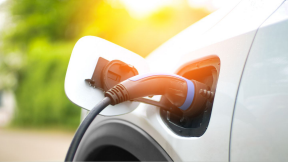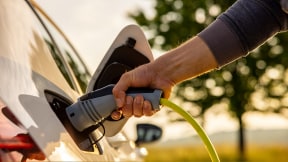EVs don’t compromise on performance

Quick insights
- The performance of electric and conventional, gas-powered vehicles is comparable.
- Hallmarks of EV performance are acceleration, power, speed and handling.
- Several components of EVs illustrate that engineering this type of vehicle doesn’t deprioritize performance on the road.
Buyers in the market for an electric vehicle (EV) tend to carefully evaluate price, battery life, charging options and range. What they may overlook is performance—the car’s acceleration, power, speed, handling and overall driving experience. EVs compare favorably or comparably to their gas-powered counterparts when it comes to performance. Here’s how.
EVs accelerate quickly
Many first-time drivers are surprised by the fast acceleration of EVs. Electric motors instantly create torque—the measurement of the force it takes to move forward—from the moment the driver hits the accelerator. This creates more push, or thrust compared to gas-powered cars, making for a smoother ride.
EVs are powerful
Electric motors prioritize energy efficiency, and this translates to powerful performance. According to the U.S. Department of Energy, EVs convert more than 77% of the electrical energy they use to power the wheels. By contrast, conventional cars convert just 12% to 30% of the energy in gasoline for the wheels because other components require more power.ec-fuel-econ-ev
EVs can go fast
Top speed is a common measure of performance for both gas-powered cars and EVs. While some EV manufacturers limit top speeds to conserve battery power,ec-elec-driver-ev there are some models that are capable of speeds in the 250 mph range and many others in the 100 mph range.
EVs brake differently
EVs have a regenerative braking system, which means the electric motor is used to both slow down the car and create more power—which feeds back into the battery to extend the battery’s range. This often means less wear and tear on the brake pads. Braking can also feel different, as drivers don’t have to apply as much pressure when the electric motor is doing some of the work to slow down the vehicle.
EVs provide a smooth and quiet ride
Another element of performance to consider is how a car drives. Because the heavy battery sits low in the car—instead of sitting over the front axle, as in a gas-powered vehicle—EVs tend to handle smoothly. The electric motor also doesn’t make much noise when operating, producing a quiet ride.
In summary
When looking at EVs, consider performance as well as price, range and battery life. EVs accelerate fast, boast considerable power, can hit high speeds and use a braking system that delivers power back into the batteries. The best way to judge an EV’s performance may be to take a test drive and experience it.
To learn more about EVs, visit chase.com/EV.



